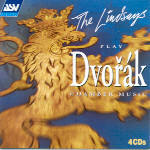Why ASV felt the compelling need to issue a four-CD set of all of its house quartet’s Dvorák recordings is beyond me, except to say that this is music-making, and music-selling, of the most cynical kind. The Lindsays have a coterie of ardent fans and critical supporters who raved about these 1990-93 recordings as individual releases. Apparently, the evidence at hand isn’t enough to dissuade those boosters, and obviously the group (and its label) is content enough with what it’s turning (churning?) out.
The set proceeds chronologically, and bizarrely, as the quality of the recordings bears an inverse relationship to their placement in the set. The performances begin magnificently and then come to an ignominious end. Particularly notable from the earliest chamber works are the Bagatelles; the harmonium, placed front and center, is a charming addition to the trio. Cypresses is made up of 12 exquisite, evocative works, and this is a nuanced performance that ironically makes the failings of many of the other recordings on this set that much clearer. The last piece on Disc 2, a full-blooded reading of the A major quintet, is the last on this set that finds the players fully engaged in their work: the rest are tossed out any which way. (The careening-out-of-control last movement of the 1879 E-flat Quartet is a warning for what lies ahead.)
The beauty found on the last two discs is so fleeting that it’s hard to recommend even one performance from beginning to end. Take the Op. 96 “American” quartet, a warhorse if there ever was one, and a work well-represented by easily available and far-preferable performances. The first movement hums along reasonably well until the last minute and a half, where we encounter an egregious edit at 8:00 on the dot. The quartet’s slow movement, nicely shaped here and undoubtedly one of the most gorgeous lentos in the literature, is jarred out of its reverie by disturbing grunts between 2:45 and about 3:20 (coming from the cellist, judging by its timing). By the Molto vivace, the Lindsays barrel through the score as if they’re late for a pressing dinner engagement. The “American” quintet Op. 97 again opens well enough, but the Allegro marking in the piece’s second movement is interpreted as an open invitation to ugly tone and manic, haphazard articulation–a recurring problem with these players. Meanwhile, the gossamer wisp of the Terzetto’s Larghetto is simply spineless. The rest of the piece is okay, although there’s a particularly gruesome patch of bad intonation at around 2:20 in the Terzetto’s last movement.
More poor playing awaits us on Disc 4. Phrasing is a major problem: The opening theme for the G major quartet’s Molto Vivace is unbearably sloppy (screeching apparently an acceptable stand-in for Eastern European rusticity). The Quartet No. 14 suffers the same fate: ugly, harsh tone every time the music surges past moderato. For all four discs (and as with The Lindsays’ other ASV recordings), the sound is very close, but not bad. If ASV is looking for more opportunities for secondary exploitation (a bloodless phrase that’s weirdly apt in this case), how about a “Best of the Lindsays’ Dvorak,” with just the materials from the first two discs? It would be a much greater value than whatever this set can offer.
































